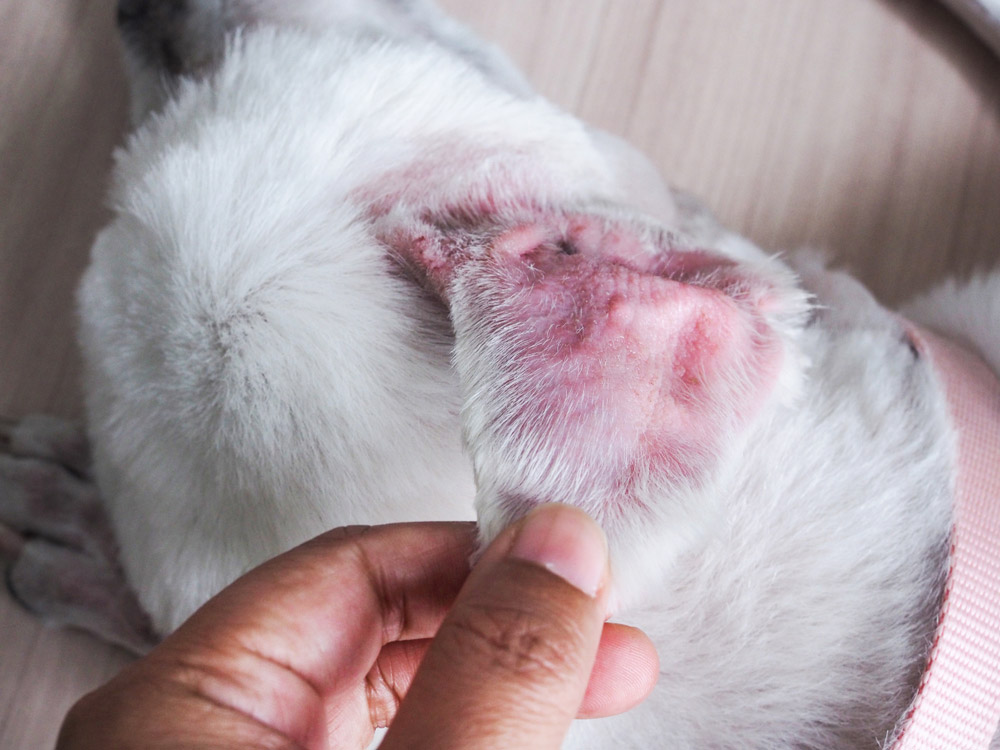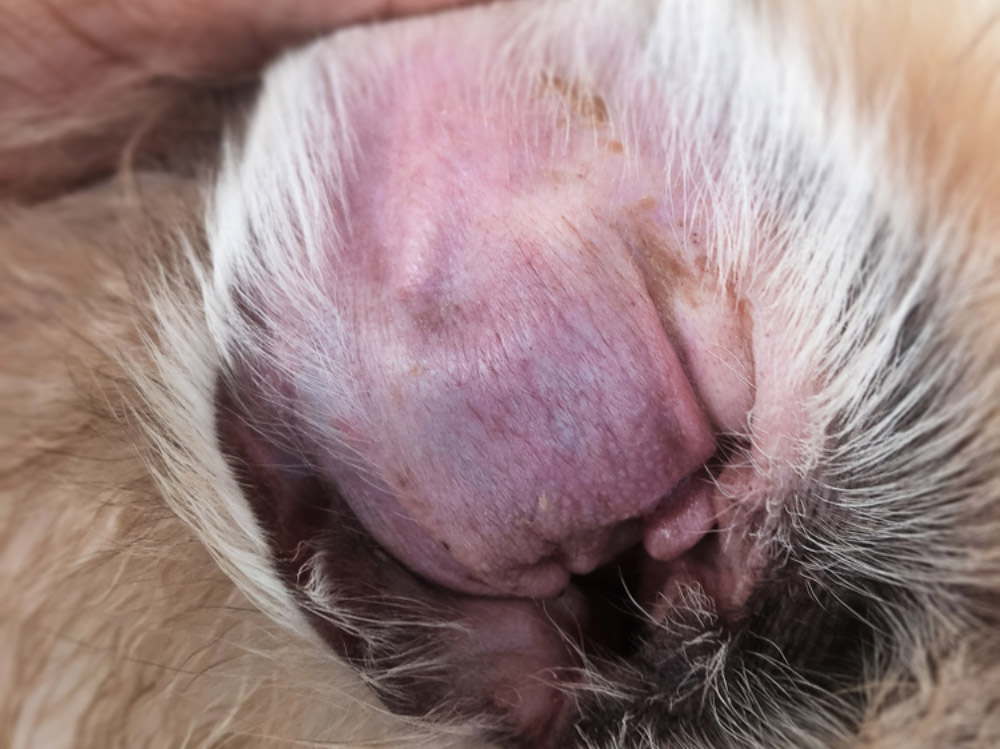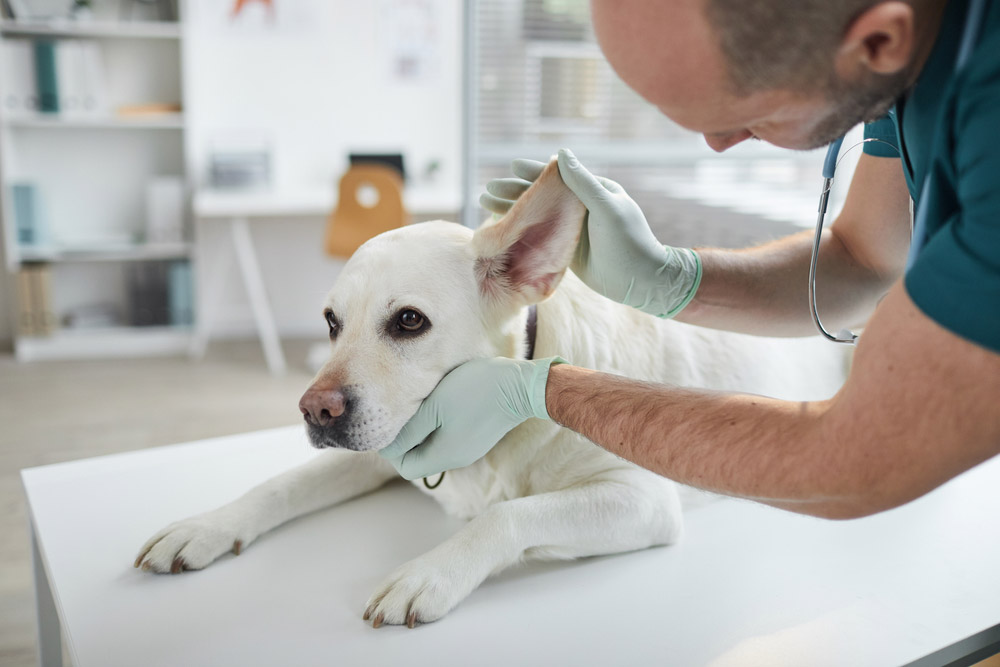Click to Skip Ahead
Dogs’ ears can become swollen or puffy seemingly overnight. It may look like your dog’s ear has become filled with air, sometimes described as looking like a pillow. However, usually the swelling of your dog’s ear is not an air pocket, but actually a pocket filled with fluid. These swellings are called ear hematomas or aural hematomas and can occur in one or both of your dog’s ears. Any age, breed, and size of dog can be affected. Continue reading to learn more about this condition, what the causes are and what to do.


What Is an Ear Hematoma?
While many people think a swollen ear in their dog is a pocket filled with air, most commonly it’s a hematoma. An ear hematoma is a pocket of blood that develops beneath the skin of the ear. A normal ear pinna has a layer of cartilage sandwiched between the inner and outer layers of skin and tissue. With an aural hematoma, fluid build up occurs in between these layers.
The fluid build-up can be fresh (otherwise known as frank) blood, clotted blood, inflammatory fluid, or a combination of these. Surprisingly, it’s rare for the fluid to contain bacteria and other infectious material.
Ear hematomas can affect one or both ears. Sometimes the pocket is very small and localized, while other times the entire ear can become severely swollen. In severe cases, swelling can even affect portions of the face and head.

What Are the Signs of an Ear Hematoma?
Most commonly, your dog will exhibit signs of an ear infection first. This can include generalized shaking of the head, scratching at one or both ears, and/or holding one or both ears down. Your dog may have a slight head tilt and be trying to rub their head or ears along the carpet or furniture. Ear infections typically have some sort of discharge associated with the ear canal. Sometimes this discharge is dark brown, other times it is purulent or appears to look like pus. In any case, there is usually some type of abnormal odor to the ear.
Because your dog has irritation to the ear(s), they will constantly traumatize the affected ear, causing the inflammation to occur. Their constant shaking, scratching, and rubbing will create the severe swelling and fluid build-up to occur. Ear hematomas can range from small, localized swellings in one ear to pillow-like swellings of the entire ear pinna. The affected ear is often uncomfortable and painful, and you may notice your dog yelping when they try to shake their head and/or scratch their ear. When you touch the swollen ear, it will often feel soft and slightly squishy.
Dogs often develop ear infections and/or ear irritation after they have been swimming or after receiving a bath. They occur when water, shampoo, and other materials get down into the ear canal, causing irritation and/or infection. A few days later, your dog may start to shake, scratch, and rub at their ears. A hematoma can develop within hours to days of these signs being present.
What Are the Causes of an Ear Hematoma?
As described above, an aural hematoma is a build-up of blood and inflammatory fluid between the layers of skin, fur and cartilage of the ear. This fluid occurs from repeated trauma to the ear. In other words, as your dog shakes their head, scratches and rubs at the ears, and the normal blood vessels within the ear pinna break, causing the blood to pool under the skin. The more your dog bothers at the ears, the worse the swelling can get.
Ear infections and ear pruritus (itchiness) are the main underlying causes of ear hematomas to develop. Ear infections, whether they are bacterial, yeast, or parasitic in nature, cause severe itching of the ears. The same can be said with allergies. Even if there is not an infection present, your dog’s ears, face, and neck may just be itchy from allergies. Once your dog starts to self-traumatize the itchy ear, the hematoma will form.
The more swollen the ear becomes, the more uncomfortable the ear becomes, and the more your dog will probably rub and scratch at them. Alas, the cycle continues and worsens.
Dogs can also get grass or other plant pieces stuck within their ears. This can cause severe irritation, and your dog will go crazy trying to scratch, paw, and rub out the material that may be stuck within the canal. As with other causes of ear irritation, your dog will then self-traumatize the ears, causing the hematoma to form.

How Do I Care for a Dog With an Ear Hematoma?
The first thing you should do when you notice your dog bothering at their ears is to make an appointment with your veterinarian. Your veterinarian will take samples of the ears and look at them under a microscope to determine if there is an underlying ear infection. If no infection is present, your dog may just have allergies causing the itching.
Ear infections are treated with some type of topical medication, either drops, ointments, or long-acting waxes your veterinarian applies to the ear canals. Allergies are best treated with either a monthly injection by your regular veterinarian, or a pill that they can take orally once daily. E-collars are often recommended so that your dog does not continue to rub their ears.
Ear hematomas can be treated in different ways. Depending on the size, your veterinarian may just treat the underlying infection and put your dog on a course of steroids to help the inflammation. Small amounts of fluid can often resorb over time, though your dog’s ear pinnas may become scarred and mis-shapen as they heal.
With severe swelling, your veterinarian may want to perform surgery. There are a few different ways that surgery is completed, but the goal is to remove the fluid from the ear. At the time of surgery, drains are placed to help the fluid continue to come out. Sometimes a head bandage is placed to absorb this fluid, or your dog may be kept in hospital for a few days while the drainage decreases.
Whichever option is chosen, it’s unfortunately very common that the hematoma can come back, even in the midst of treatment. If your dog is prone to allergies and/or ear infections, they may have more ear hematomas throughout their life. It’s also important to not treat the ears at home. Diagnostic tests are needed to determine what type of infection may be present (if at all), and cleaning the ears with alcohol, peroxide, apple cider vinegar, mineral oil, and essential oils are not only irritating, but can make the infection worse. It’s also never recommended to drain the fluid yourself at home.


Frequently Asked Questions (FAQ)
How Long After Surgery Will the Ear Heal?
This depends on how severe the swelling is, if both ears are affected, and what the cause of the itching is. Simple cases can be healed within a week. While more severe cases may take a few weeks to go back to normal.
What If I Don’t Treat It?
There are many veterinarians who won’t recommend or perform surgery, at least the first time, due to the risk of recurrence. The hematoma fluid may resorb with time without any treatment. However, the cause of the itching and ear irritation has to be addressed. In other words, the infection, plant material and/or allergies need to be addressed. Without it, your dog will just continue to shake their head and traumatize their ears.



Conclusion
When your dog’s ear swells up, it’s typically not an air pocket, but a pocket of fluid known as an ear hematoma. A hematoma contains blood and inflammatory fluid that builds up beneath the skin of one or both ear flaps (the pinna). This occurs when your dog shakes their head, scratches, and/or rubs their ears, causing inflammation. Your dog will typically do this if they have an ear infection, something stuck in their ear, or allergies. A veterinarian will need to diagnose what is causing the ear irritation, and then treat both that and the hematoma. Sometimes a combination of oral and topical medications can be used, while other times surgery is needed. Prognosis is good for a complete recovery, though it can recur. Unfortunately having surgery once does not mean that it won’t occur again in the future. Home treatments are never recommended for either the underlying ear infection, irritation, and the hematoma.
Featured Image Credit: Sathmini Wijethunga, Shutterstock



























